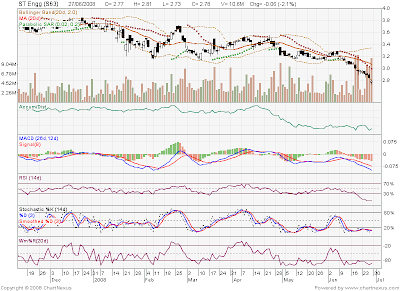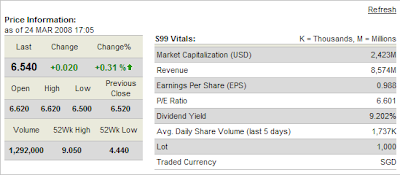Balance Sheet - how much money the company owes and its net worth
- Current assets : cash and assets that can be turned into cash in a relatively short period
- T-bills
- Inventories that are finished products ready for sale or products that are in process of being manufactured
- Receivables from customers who have bought their products
- Current liabilities : debts that fall due within a year or less
- Interest payment on company borrowings
- Account payable to the company's suppliers
- Taxes owed but not yet paid
- Current Ratio = Current Liabilities / Current Assets
- Companies ability to pay its short-term obligations
- Guideline: 2-to-1 ratio
- Compared with other companies, LOWER ratio means possible LIQUIDITY PROBLEM
- Steadily declining year over year means SERIOUS LIQUIDITY PROBLEM
- Working Capital = Current Assets - Current Liabilities
- Guideline : The more the better
- Quick Ratio = (Current Liabilities / Current Assets) - Inventories
- Rising inventories may indicate a product that has decreased in popularity and will be difficult to sell at a profit
- Long-term assets
- Real estate, Factories, Warehouses and equipment
- Investment in subsidiaries or stocks that is not intended to be sold
- Intangible assets such as patents, trademarks, copyrights (usually not taken into consideration because difficult to get exact valuation)
- Long-term liabilities
- Bank loans
- Public and private bond issues
- Long-term leases for property or equipment
- Shareholder Equity (Book value) = Assets - Liabilities
- Liabilities growing faster than assets means company has to borrow more and more money just to stay afloat
- Debt-to-Equity Ratio = Total Debts / Shareholder Equity
- Guideline: less than 1
- If number is higher than 1, company is funded primarily by debt rather than equity investment
Income Statement - how much money the company took in over a period of time (sales or revenue) and how much it paid out (expenses)
- Company's sales or revenues
- To be compared to previous years
- Guideline: Revenues growing over time
- Cost of goods sold : direct cost of producing product or service the company sells
- Raw materials
- Manufacturing or labor costs of making product
- INCREASING % of (COGS / revenues) means rising costs that cannot be passed on to the costumers are squeezing the long-term potential for profit
- Gross profit = Revenues - COGS
- % Gross Profit Margin = Gross Profit / Revenues
- Guideline: steadier gross profit margin means better business
- Operating expenses : selling, general and administrative expenses
- Guideline: Lower % of (Operating Expense / Revenue) is better
- Operating Profit (EBIT : Earnings Before Interest and Taxes) = Gross Profit - Operating Expenses
- Net Profit (Final Earnings) = Operating Profit - Interest Expense - Taxes - Depreciation
- Earnings Per Share (EPS) = Net Profit / Outstanding Shares
- Diluted EPS : taking into consideration stock options, issued bonds, preferred stock or warrants are converted to stock
- Guideline : Diluted EPS very much lower than EPS means earning is not as cheap
- Recommended to use EBIT instead of Net Profit
- Questions on Trend over 5 or 10 years:
- Are revenues rising or falling?
- Are expenses staying in line with revenues?
- Are profits consistent or uneven?
- Is there a cyclical pattern to earnings such as would be the case with economically sensitive companies?
- Are profits growing?
- Are there a lot of one-time charges or gains to indicate the company may be manipulating or massaging the bottom line?
- Are shares outstanding decreasing?
- Rising shares outstanding indicate excessive stock options are being granted to executives and will dilute share of corporate profits
- Company is financing itself through stock offerings rather than earnings
- Return on Capital (ROC) = Earnings / Beginning Year Capital (stockholder Equity + Debt)
- Rising ROC means company is doing a good job of reinvesting profits
- Net Profit Margin = Earnings / Total Revenues
- Guideline: avoid companies with declining Net Profit Margin
The book The Little Book of Value Investing (Little Books. Big Profits)




